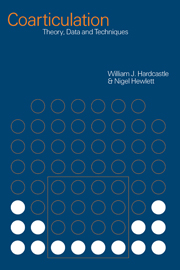Book contents
- Frontmatter
- Contents
- List of figures
- List of tables
- List of contributors
- Acknowledgments
- Introduction
- Part I Theories and models
- Part II Research results: components of the motor system for speech
- Part III Wider perspectives
- 8 Cross-language studies: relating language-particular coarticulation patterns to other language-particular facts
- 9 Implications for phonological theory
- Part IV Instrumental techniques
- References
- Index
8 - Cross-language studies: relating language-particular coarticulation patterns to other language-particular facts
Published online by Cambridge University Press: 22 September 2009
- Frontmatter
- Contents
- List of figures
- List of tables
- List of contributors
- Acknowledgments
- Introduction
- Part I Theories and models
- Part II Research results: components of the motor system for speech
- Part III Wider perspectives
- 8 Cross-language studies: relating language-particular coarticulation patterns to other language-particular facts
- 9 Implications for phonological theory
- Part IV Instrumental techniques
- References
- Index
Summary
Introduction
This chapter focuses on cross-language studies of coarticulation. It addresses, in part, the question of why coarticulation patterns appear to be different in different languages. I will concentrate mostly (but not exclusively) on studies of non-Indo-European languages. For related discussion of cross-linguistic aspects of coarticulation, focusing more on Indo-European languages, the reader may wish to consult Farnetani (1990). In addition to referring to some of the classic works on cross-language studies of coarticulation, I have chosen to emphasize several recent studies, many of which are based on doctoral dissertations or conference papers. The rationale behind this choice is two-fold. First, much of the work which specifically addresses the question of cross-language aspects of coarticulation and which evaluates non-Indo-European languages has been completed by doctoral students. Second, precisely because some of these works do not yet appear in widely available formats, they may be unfamiliar to many readers.
Often the term coarticulation is restricted, at least implicitly, to clear cases of contextual variation in the way a segment appears to be produced, such as nasalization of vowels before nasal consonants. In this chapter coarticulation is defined rather more broadly, as patterns of coordination, between the articulatory gestures of neighbouring segments, which result in the vocal tract responding at any one time to commands for more than one segment. Of course, according to this definition, it is almost impossible to produce an utterance that is more than one segment long without engaging in coarticulation.
- Type
- Chapter
- Information
- CoarticulationTheory, Data and Techniques, pp. 179 - 198Publisher: Cambridge University PressPrint publication year: 1999
- 29
- Cited by

